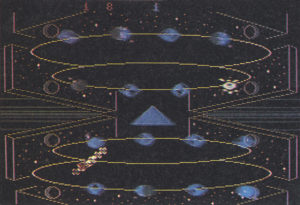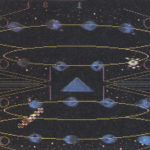
This game and Break Street were supposed to be Firebird’s proof that budget games could be quality games too according to Martin Defries, who was sales manager of Telecomsoft at the time. Pyramid of Time was for 1 or 2 players and was “quite spacey” according to Soft magazine (pages 9-10, issue 2, 1988 for reference).
Zzap first mentioned news of the game in issue 26, along with a few others:
“Hot on the heels of the latest Activision re-releases come four more golden oldies – Futureball, Pyramid of Time, Pitfall and Break Street.
The former is an odd sort of game, where the player takes control of a ball and has to escape from a network of pipes before water floods the whole system. Strange but true, and you only have to wait a month to find out more!
A whacky and way out experience is to be had in Pyramids of Time, written by Russell Lieblich, the author of Master of the Lamps.”
Even stranger is the fact that ZZAP printed a full review in issue 31 (page 134, November 1987), awarding a mark of 78%.
But what was it like? Only one screenshot remains, with the text of the ZZAP review left to explain what you had to do:
“Set some time in the future, sports are played in huge arenas in space. Pyramid of Time is one such game. When the brilliant title screen appears you have the option to choose a one or two player game. Each contestant then jetpacks down to the arena and boards his chosen vessel from the three available.
The game continuously cycles between two main stages; the Pyramid screen [pictured in the ZZAP review] and the bonus grid screen. Entering the former sees the central spinning pyramid surrounded by four layers of revolving diamonds, which randomly turn into glowing gems and planets.
Shooting the gems gains points, and blasting a planet alters its colour to that of the contestant’s ship. Warping to the bonus level causes the grid to appear. This is a strange, colourful pulsating network of pathways, along which the two vessels move. During this section, the object is to collect the available gems before being returned to the Pyramid screen.”
The review went on to comment that the game was strangely addictive and extremely well presented – especially in the sound department.
So what happened to it?
Richard Hewison found out from Colin Fuidge (who worked on the budget range for Firebird) that the game couldn’t be converted to tape, which made it impossible to publish. The game was apparently very weird overall.
The game was (according to Glyn Anderson) the brainchild of the late Russell Lieblich, who was the main programmer. He was doing all the sounds and music too. Glyn however helped with a bit of navigation code and wrote the bonus level where you navigate a moving grid.
We are told that the game was never released due to Activision thinking that the market would not accept the game. It seems that Firebird had the best opportunity, but due to it probably being a set of master disks – this may have made it hard to transfer by the company. It is odd though that it was sent to Zzap before this was established.
It is hoped that Glyn may have something of the game, but it is unlikely. Any copies sent to Firebird and Zzap seem to be long gone too, and it could be a miracle now to see anything turn up.
Contributions: Richard Hewison, Anders Hansen, Glyn Anderson, Peter Kaminski, Joachim Wijnhoven
Supporting content
Gallery
Creator speaks
Glyn Anderson talks about work on Pyramid of Time:
“Pyramid of Time” was the brainchild of Russell Lieblich, who was the principal programmer on the title. He also did all the artwork, sounds and music. I helped Russell with the navigation code on the main game screen and I also wrote the bonus level, in which one navigates a moving grid. This game was never released for the same reason as Future Ball.
An earlier game by Russell, “Web Dimension”, was similarly psychedelic and freeform, and similarly misunderstood by marketing and the market. Russell wanted to create “experiences” that you could lose yourself in and achieve that state of “Zen” that comes when you’re focused so completely in an activity that it becomes no longer fully conscious.
The Pyramid of Time page credits Russell Lieblich as the author of Master of the Lamps, which is partly true. Russell wrote all of the music and sound effects for the game, and co-designed it with Peter Kaminski, but Peter gets credit for programming the game. Russell was working on other things at the time.
Some trivia about Master of the Lamps: New players are often initially confounded by the first level’s magic carpet ride, as they get used to the flying mechanic. They tend to overcompensate their moves and get into a positive-feedback loop, their avatar careening from one side to the other. In fact, the level can be completed by putting the joystick down and not touching it. The path is essentially a straight line!”
Update history
01/04/22 – Tidy up of the page.



Thank you for this article.
I’ve just read the Zzap! review, after looking for a different game entirely, and thought it would be interesting to check out.
Oh well!